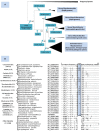Commentary: Genome-Based Taxonomic Classification of the Phylum Actinobacteria
- PMID: 30853945
- PMCID: PMC6395429
- DOI: 10.3389/fmicb.2019.00206
Commentary: Genome-Based Taxonomic Classification of the Phylum Actinobacteria
Keywords: Priority of taxonomic names; division of the family Mycobacteriaceae into five genera; family Mycobacteriaceae and the order Mycobacteriales; genus Mycobacterium; order Corynebacteriales; prokaryotic taxonomy.
Figures

Comment on
-
Genome-Based Taxonomic Classification of the Phylum Actinobacteria.Front Microbiol. 2018 Aug 22;9:2007. doi: 10.3389/fmicb.2018.02007. eCollection 2018. Front Microbiol. 2018. PMID: 30186281 Free PMC article.
Similar articles
-
Mycobacteriales taxonomy using network analysis-aided, context-uniform phylogenomic approach for non-subjective genus demarcation.mBio. 2023 Oct 31;14(5):e0220723. doi: 10.1128/mbio.02207-23. Epub 2023 Oct 5. mBio. 2023. PMID: 37796005 Free PMC article.
-
On the status of the names Corynebacteriales Goodfellow and Jones 2015, Mycobacteriales Janke 1924 (Approved Lists 1980) and Mycobacteriales Cavalier-Smith 2002.Int J Syst Evol Microbiol. 2019 Oct;69(10):3310-3312. doi: 10.1099/ijsem.0.003481. Epub 2019 Jun 3. Int J Syst Evol Microbiol. 2019. PMID: 31157615
-
Fundamental Cell Morphologies Examined With Cryo-TEM of the Species in the Novel Five Genera Robustly Correlate With New Classification in Family Mycobacteriaceae.Front Microbiol. 2020 Nov 16;11:562395. doi: 10.3389/fmicb.2020.562395. eCollection 2020. Front Microbiol. 2020. PMID: 33304323 Free PMC article.
-
Korean indigenous bacterial species with valid names belonging to the phylum Actinobacteria.J Microbiol. 2016 Dec;54(12):789-795. doi: 10.1007/s12275-016-6446-4. Epub 2016 Nov 26. J Microbiol. 2016. PMID: 27888457 Review.
-
On molecular taxonomy: what is in a name?Exp Appl Acarol. 2004;32(4):301-12. doi: 10.1023/b:appa.0000023235.23090.a7. Exp Appl Acarol. 2004. PMID: 15176735 Review.
Cited by
-
Mycobacteriaceae Phenome Atlas (MPA): A Standardized Atlas for the Mycobacteriaceae Phenome Based on Heterogeneous Sources.Phenomics. 2023 Jun 13;3(5):439-456. doi: 10.1007/s43657-023-00101-5. eCollection 2023 Oct. Phenomics. 2023. PMID: 37881319 Free PMC article.
-
Tip extension and simultaneous multiple fission in a filamentous bacterium.Proc Natl Acad Sci U S A. 2024 Sep 10;121(37):e2408654121. doi: 10.1073/pnas.2408654121. Epub 2024 Sep 3. Proc Natl Acad Sci U S A. 2024. PMID: 39226354 Free PMC article.
-
Schaalia turicensis endometritis in a diabetic patient: MALDI-TOF MS overcomes diagnostic barriers in a non-IUD-associated case.Front Med (Lausanne). 2025 Aug 5;12:1593385. doi: 10.3389/fmed.2025.1593385. eCollection 2025. Front Med (Lausanne). 2025. PMID: 40837572 Free PMC article.
-
Efficient Stereochemical Analysis of Hydroxy Fatty Acids Using PGME and PAME Derivatization.Anal Chem. 2025 Jul 1;97(25):12947-12952. doi: 10.1021/acs.analchem.5c01447. Epub 2025 Jun 19. Anal Chem. 2025. PMID: 40537384 Free PMC article.
-
Responses to Ecopollutants and Pathogenization Risks of Saprotrophic Rhodococcus Species.Pathogens. 2021 Aug 2;10(8):974. doi: 10.3390/pathogens10080974. Pathogens. 2021. PMID: 34451438 Free PMC article. Review.
References
-
- Goodfellow M., Jones A. L. (2012). Order V. Corynebacteriales ord.nov, in Bergey's Manual of Systematic Bacteriology, Vol. 5, Actinobacteria, eds Goodfellow M., Kampfer P., Busse H. J., Trujillo M. E., Suzuki K., Ludwig W., Whitman W. (New York, NY: Springer; ), 235–243.
-
- Gupta R. S. (2018). Impact of genomics on clarifying the evolutionary relationships amongst Mycobacteria: identification of molecular signatures specific for the tuberculosis-complex of bacteria with potential applications for novel diagnostics and therapeutics. High Throughput 7:E31. 10.3390/ht7040031 - DOI - PMC - PubMed
-
- Gupta R. S., Chen W. J., Adeolu M., Chai Y. (2013). Molecular signatures for the class Coriobacteriia and its different clades; Proposal for division of the class Coriobacteriia into the emended order Coriobacteriales, containing the emended family Coriobacteriaceae and Atopobiaceae fam. nov., and Eggerthellales ord. nov., containing the family Eggerthellaceae fam. nov. Int. J. Syst. Evol. Microbiol. 63, 3379–3397. 10.1099/ijs.0.048371-0 - DOI - PubMed
Publication types
LinkOut - more resources
Full Text Sources

